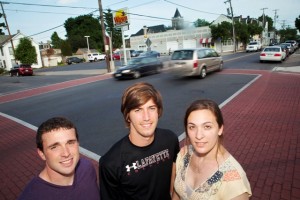Students and College Hill residents agree: The dangerous intersection of Cattell and High streets near the WaWa convenience store crosswalk is a problem. But, what to do about it?

Ryan Mc Veigh ’13, Nicholas Hepp ’13, and Diana Giulletti ’13 at the intersection of Cattell and High streets as traffic speeds by
Chemical engineering major Diana Giulietti ’13 (Pawcatuck, Conn.) suggested making a “bead” curtain of reflective disks draped over the road as a way to alert drivers to reduce speed. Engineering studies majors Nicholas Hepp ’13 (Sarasota, Fla.) and Ryan McVeigh ’13 (River Edge, N.J.) proposed rerouting traffic from Forks Township to Easton to alleviate congestion on Cattell Street.
Those were just a couple solutions to the problem posed by Benjamin Cohen, assistant professor of engineering studies, and Nestor Gil, assistant professor of art. Students in Cohen’s capstone Engineering and Society course and Gil’s Sculpture Against the Digital Horizon class had one week to define the problem, understand the contexts that produced the problem, propose a solution including an assessment of the time and cost, and prepare a short presentation of their ideas for their classmates and a panel of three faculty judges.
Giulietti, who enrolled in Gil’s art course, enjoyed tackling the WaWa project through an artistic, rather than engineering, lens. Her bead curtain would provide a physical obstacle, refract light to function as a “flashing” light, and subconsciously trick drivers into slowing down by giving the illusion that vehicles are moving twice as fast due to the reflection.
“I liked presenting to my engineering peers from a different perspective,” she says. “I know the way engineers think, and that’s why my idea was purposefully outlandish—to challenge the rigid creative process that engineers sometimes follow. Obviously, we wouldn’t want to scratch cars or block the view of the crosswalk, but it’s a different way of thinking. This is why we need multidisciplinary groups to solve problems.”
That was the exact purpose of the project, says Cohen. And what better way for students to practice that than by looking at a problem in their own backyard?
“We have to question assumptions, but it’s in the doing where it matters and starts to become meaningful,” Cohen says. “I can talk about question this and question that all day long, but an exercise like this can help students find, from their own work, that they have assumptions that could be questioned.”
McVeigh and Hepp believe that the obvious problem of too much traffic is a symptom of the deeper problem of a fast-growing population in Forks Township—more people leads to an increase in commuters using Cattell Street to access Easton and Routes 22, 33, and 78. The most logical solution, they proposed, is creating an alternate route capable of handling higher traffic volume. Their idea is expensive, requiring construction of an additional road to avoid College Hill altogether, but received the highest marks from the judging panel.
McVeigh, who has accepted a position as a project engineer for Saugatuck Construction Group in Stamford, Conn., after graduation, learned a great deal from the other presentations and solutions, especially ones proposed by the art students.
“For a solution to be implemented, it has to do more than just work,” he says. “The aesthetics of an implementation can be just as important to a community as the actual purpose it serves. The solutions varied greatly, and the project offered various perspectives that I would not have seen on my own.”
That is the beauty and benefit of interdisciplinary collaboration.
“A given discipline is a way of seeing the world, a way of asking questions, a way of investigating,” says Gil. “The opportunity to approach a problem in a manner that brings disparate ways of seeing, asking, and investigating into dialogue with one another can open the door to generating new knowledge and new ways of knowing our world.”
Hepp agrees: “It was particularly interesting how some groups looked at nature and art as a model for their design. You must analyze a problem from many different perspectives in order to develop the best possible solution that will create the greatest benefit for society, local businesses, and residents.”

2 Comments
I love all the ideas, but I especially like the reflective curtain idea. As a $300 tax has now been imposed upon commuting residents, I worry about the possibility of such taxes, or Easton taxes themselves, increasing. As this area, including the surrounding communities, houses many middle class families, this increase, added to the increase to taxes all around, will cause hardship that will not be rectified even after the project is complete!
Well done on your work!
Why not a nice brick round about with something about Lafayette in the center? Other places have done that and they really look nice. Often the ‘corners’ themselves get new landscaping. Have the students make an environmental ‘town and gown’ project out of it.
Comments are closed.